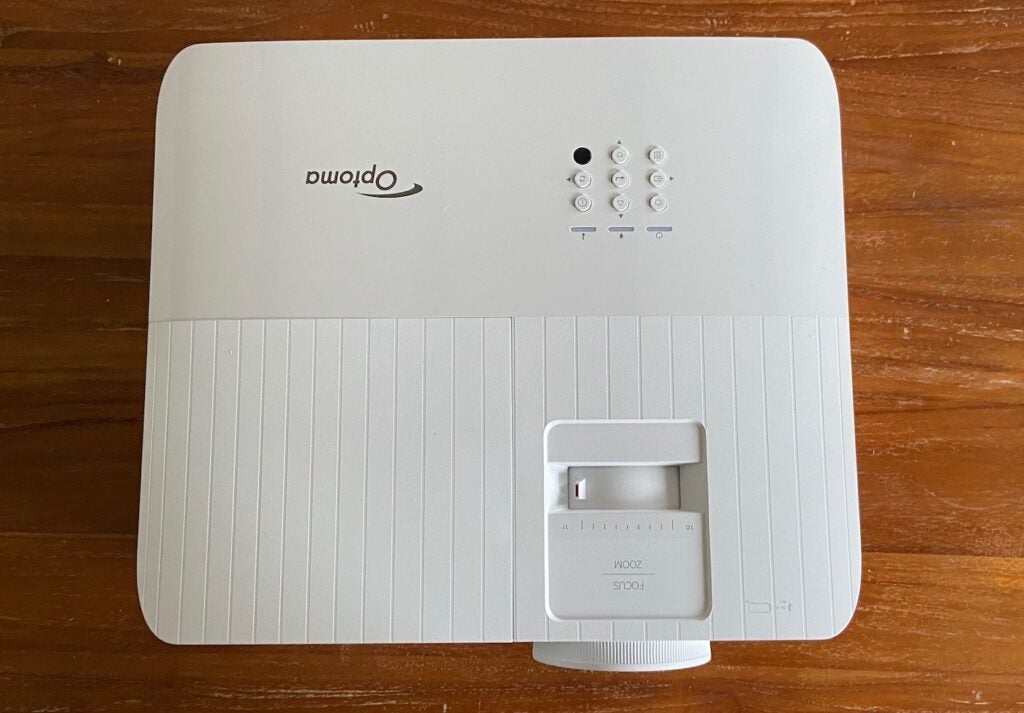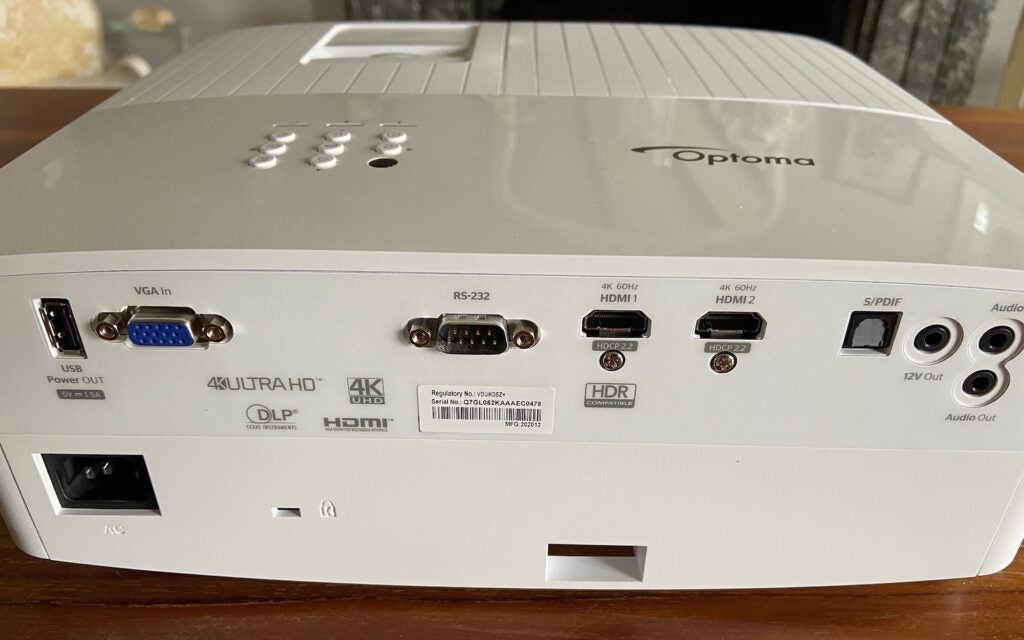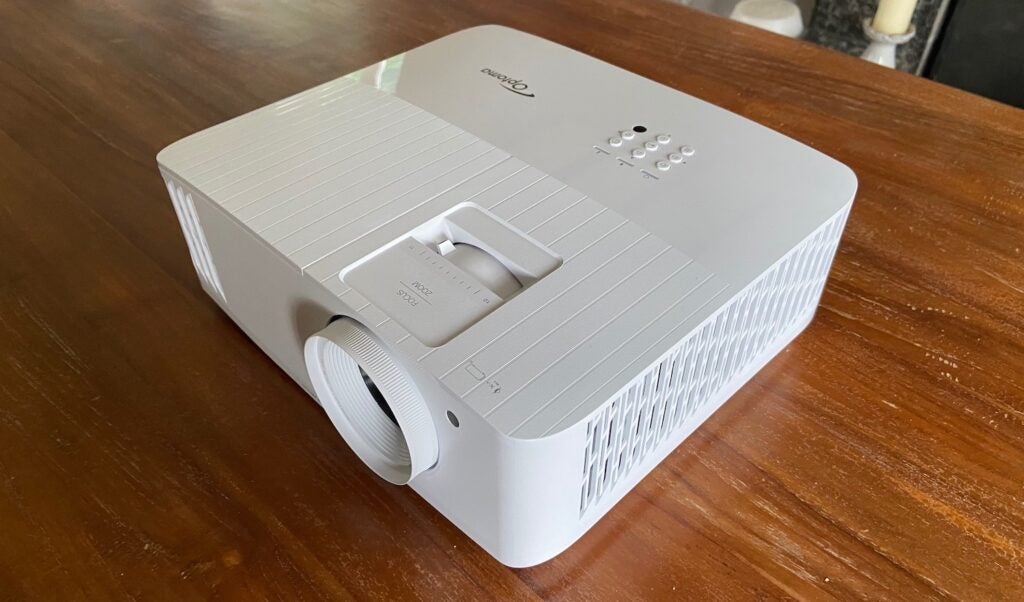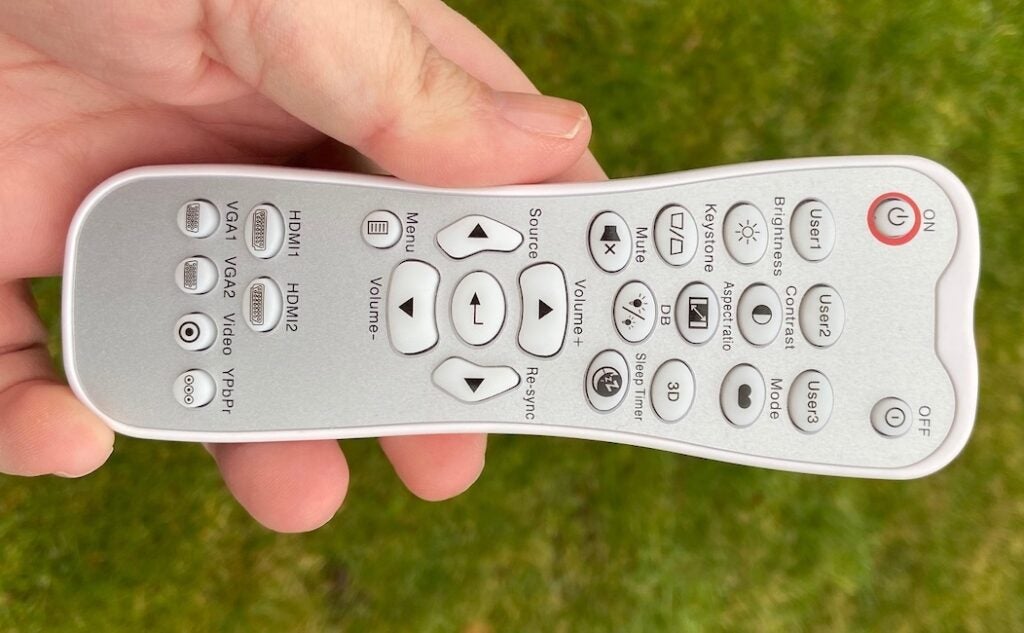Optoma UHD38 Review
Provided your room is big enough to get a good sized image out of the UHD38, it's the most gaming-friendly projector yet


Verdict
If your room is hard to fully black out and big enough to cope with the UHD38’s curiously long-throw lens, the Optoma UHD38 is the most all-round effective and engaging gaming projector in town.
Pros
- Seriously bright, crisp images
- Super-fast response time in Enhanced Gaming mode
- Bold colour and HDR performance
Cons
- Black levels are very average in HDR
- Some clipping with HDR
- Long-throw lens seems an odd choice for a gaming projector
Availability
- UKRRP: £1099
- USATBC
- EuropeTBC
- CanadaTBC
- AustraliaTBC
Key Features
- HDRHDR10 and HLG
- DLP‘4K’ single-chip DLP projector with a gaming focus
- Refresh rate4K at 60Hz and 1080p at 120 and 240Hz support
Introduction
Having struck gold in the exploding gaming display market with last year’s console focused UHD30, Optoma is out to boost your kill to death ratio even further with the UHD38.
Among this ‘4K’ £1,099 DLP projector’s game-friendly charms are high dynamic range support, an ultra-fast response time, game-tuned pictures, (HD) high refresh rates and even a 32:9 aspect ratio option.
Design
- Small footprint
- Good remote (also features backlit keys)
- Grilles on side let some light escape
For a light cannon apparently capable of pumping out 4000 ANSI Lumens of brightness, the Optoma UHD38 is surprisingly small. Its squarish footprint fits easily on typical sofa-side coffee table – though it’s slightly heavier, taller and more robustly built than most ‘casual’, living room projectors.
It’s also tastefully dressed in a crisp white livery with a two-tone top plate that features a high-gloss finish on its rear half, and a matte textured front half with gloss stripes. The rear half of the top edge hosts a selection of control buttons, and a window in the front half provides access to a simple rotating zoom adjustment. The protruding ring around the lens provides a simple focus adjustment.

The remote accompanying the UHD38 is small but comfortably shaped. It also manages to provide reasonably well spaced and large buttons despite its small size. Best of all, every button is backlit so intensely you can use the remote as a torch if you’re struggling to find your chips and dips in the dark.
The only bum note in the UHD38’s design is the heavy grilling down each side. Not because it looks ugly (it doesn’t), but because it allows some light to spill out, which could distract if the projector’s sides are in your line of view.
Features
- Super low latency for gaming
- A claimed 4000 lumens of brightness
- Not a native 4K projector
Plenty of projectors claim to be game friendly, but few, if any, back that up with actual game-related features as much as the Optoma UHD38.
For instance, its input lag – the time it takes to render an image – is outstanding. Choose the Enhanced Gaming setting and input lag with 4K/HD 60Hz sources drops to 16.7ms. This is exceptionally low for a projector, and even beats most of the latest TVs. What’s more, this already low figure reduces to 8.9ms and 4.2ms if you’re feeding the projector 1080p 120Hz or 240Hz images, respectively.
The fact that such feeds are supported is another big tick in the UHD38’s gaming box, as is its support for the 32:9 aspect ratio some first-person shooter titles provide as an option. Do note that the projector’s two HDMI only support 4K games at up to 60Hz; the 4K@120Hz of the latest consoles and PCs are off the table. There’s no support for variable refresh rates, either.

The claimed 4000 ANSI lumens of brightness (the step-down £999 UHD35 model drops to 3600), should help in expressing the increasingly strong HDR implementations we’re starting to see in games, as well as potentially enabling you to play with the level of ambient light in a room. Many households won’t have a dedicated blacked out room, and regular living spaces are notoriously hard to keep completely dark.
One concern with any projector that claims brightness levels this high is contrast and black level response. Optoma claims a theoretical contrast ratio of 1,000,000:1 using the UHD38’s ‘Dynamic Black’ feature, and I’ll be surprised if this turns out to be anything more than wildly optimistic.
Moving away from gaming-specific features, the UHD38 supports standard HDR10 and broadcast/live stream-friendly HLG HDR formats. There’s no Dolby Vision support, but no other mainstream projector currently supports it either.
The UHD38 is not a native 4K projector in the same way as Sony’s 4K SXRD projectors. It doesn’t carry a native array of 3840 x 2160 of DLP technology’s digital mirror devices. Optoma is keen to point out that the US Consumer Technology Association (CTA) considers the way DLP projectors create 4K by multiple flashes of their DMDs for each frame to offer a genuine 4K experience. It’s a consideration the CTA does not extend to pseudo-4K LCD/e-Shift projectors.
The Optoma UHD38 can support (that’s not the same as fully deliver) Rec.709 and DCI-P3 colour gamuts, and deploys an eight-segment colour wheel rather than the sort of six-segment affair usually found at this level.

As well as its two HDMIs, the UHD38’s connections include a 12V trigger port for, say, calling out a motorised screen; an RS-232 port to aid integration into a wider home automation system; a D-Sub PC port (underlining its interest in gaming); a 5V powered USB port for potentially powering HDMI video dongles; and 3.5mm audio input/output jacks. These audio ports indicate the presence of a built-in sound system. This one claims a promising 10W of output power.
Two final big numbers that stand out are support for images up to 300 inches (a figure more realistic than usual thanks to the projector’s high brightness), as well as a claimed 15,000 hours of lamp life if you use the projector’s adaptive lamp controls. This figure drops to a few thousand hours if you spend most of your time using the HDR-friendly Bright lamp setting.
When it comes to image set up, while the UHD38 boasts a full suite of colour and gamma management tools, complete with ISF calibration certification, it’s unfortunately lacking a couple of key basics.
For starters, it only supports 1.1x optical zoom – a puny degree of flexibility for a ‘convenience’ projector. This limitation is made worse by the UHD38’s use of a surprisingly long-throw lens. To get a 100-inch image, for instance, you’ll need at least 11 feet between the projector and your screen. Hardly ideal for a bedroom, study or spare room. It could also force you to place the projector amid your seating positions in a living room environment. The UHD38 does carry a digital zoom option, but this degrades image quality and so I wouldn’t recommend it.
There’s also no optical horizontal or vertical image shifting on the UHD38. That makes it more likely that to get the edges of your image perpendicular, you’ll need to resort to using either the provided digital keystone correction or the (unusual) option to adjust the position of each of the image’s corners. Again, features like this are essentially digitally distorting the image, and are best avoided.
One last feature of note is 3D support. As usual, no 3D glasses are included for free.
Picture Quality
- Blacks look washed out
- Brightness helps deliver wide colour range
- More tuned for gaming than film watching
First impressions of the Optoma UHD38 suggest a projector that’s such a game of two halves it’s hard to know what to make of it.
Let’s start with the bad news: its black levels are very average, especially with HDR sources.
The focus on brightness really takes a toll on the UHD38’s ability to deliver convincing, compelling dark scenes. Everything that should look black/dark instead looks grey and washed out. So much so, that colours in dark areas can look flat and muted.
Switching from the default Bright lamp output setting to Eco+ or Eco can improve black levels a little, but only at the expense of some image stability in the case of Eco+, and hefty levels of brightness in Eco mode. And, in neither of these other lamp modes do black levels improve massively with HDR, meaning you’ll likely end up coming back to the punchier Bright default lamp setting.
The Optoma UHD38 also sometimes presents very dark HDR shots with a slight ‘glow’; a glow that very occasionally adopts a gentle reddish undertone. The UHD38’s black level difficulties highlight another flaw: a grey frame around the main image’s edges. If you’re using a projection screen you may be able to hide this light frame in your screen’s borders. This won’t be possible if you’re projecting onto a wall.
At the other end of the brightness spectrum, the brightest parts of HDR images are prone to clipping where subtle details and shading are swallowed up in a vague white ‘flare’. As I’ll detail more later, this is actually an easier compromise to accept in return for the UHD38’s HDR brightness than its shallow black levels.
Some colour tones, especially bright greens, can look off with the very brightest HDR footage. And you can also sometimes spot signs of mild banding in areas of fine HDR colour blends.
As much as the UHD38 struggles with dark HDR scenes, it excels with bright ones. The vast majority of those 4000 lumens of brightness really do find their way to your wall or screen, getting more value out of the bright end of HDR’s luminance spectrum than any other projector I’ve seen at the UHD38’s price.
Even better, the extreme brightness feeds into an unusually wide colour range for such an affordable projector. Rich reds and blues enjoy remarkable volumes for a projector. Yet, they achieve this without looking gaudy or out of balance with the rest of the colour palette, despite there being no wide colour filter in play with this projector.

Inevitably, the UHD38’s brightness can occasionally outstrip its colour capabilities. But this happens much less often than I’d expected it would.
The UHD38’s innately shallow black levels mean it’s not delivering a true sense of the ‘range’ part of HDR in the same way that, say, the clever new processing in Sony’s far more expensive new VW590ES and VW790ES projectors does. Optoma is just focusing on the bright part of the HDR deal.
The overall watchability of the UHD38’s HDR images suggests that when you’re dealing with the light control compromises associated with affordable/living room projectors, pushing brightness over black level arguably makes more sense.
This is especially true given the UHD38’s self-proclaimed gaming focus. The results I’ve reported so far have largely being noted while watching films, yet with games the focus on brightness and rich colours works even better, while the limited black levels feel less problematic.
Gaming makes you more aware that while the UHD38’s black levels might not get very deep, there’s still plenty of shadow detailing to be found in dark picture areas. So you can still see enemies skulking in dark corners, and dark game locations still feel almost as three-dimensional as bright ones.
Basically, the UHD38’s images really do seem to have been tuned first and foremost for games.
While it would have been fantastic if the UHD38’s pictures could adapt themselves better to dark room movie viewing as well, Optoma is clearly promoting this as a gaming projector first and foremost. So you can’t really have a go at it for doing exactly what it set out to do.
Especially when other aspects of the UHD38’s pictures also work so well for gaming. The responsiveness of the image using the Enhanced Gaming setting really is something, especially when playing at high frame rates. Motion and pans are rendered extremely well, with no ‘hardware’ judder or any of the fizzing noise over certain (especially skin) colour tones that single-chip DLP projectors once routinely suffered with.
Native 4K game and video sources both look seriously sharp and detailed, too. Not as pristine as Sony’s native 4K models, but better than HD, and outstanding for a £1,099 projector.
The UHD38’s intense brightness helps images stand up remarkably well in ambient light. In fact, its pictures are arguably at their best with a little ambient light to contend with, since such a situation hides the projector’s black level shortcomings. So while it might have been nice if the UHD38 was a bit more adaptable to dark room viewing, you can certainly understand the image tuning choices Optoma has made for what is a projector designed with game usage in mind.

If you’re still into 3D, the Optoma UHD38 handles it well. There’s scarcely a hint of crosstalk noise (double ghosting), even in images with extreme levels of depth. Detail levels are high, the sense of depth and space is typically excellent, and motion is exceptionally well presented; with none of the billowy, strobe appearance other 3D projectors can suffer with. Black levels look more convincing in 3D than they do in 2D, too.
During very dark scenes the 3D effect can become a little garbled, as your eyes struggle to discern key depth ‘cues’. Also, the amount of brightness you lose when you don a pair of active shutter 3D glasses feels greater than usual. But that’s more because the UHD38’s 2D pictures look so bright than because its 3D images look especially dark.
Note that you should stick with the Bright lamp setting for 3D, as the initially impressive looking Eco+ alternative causes some distracting brightness instability and heavy colour banding.
With 2D SDR sources, since the UHD38’s image doesn’t need to be driven so hard, it’s able to achieve more natural and convincing black levels. Colours look subtle and consistently natural, and HD imagery still looks impressively detailed and crisp.
The projector handles SDR image noise very naturally too, even with fairly compressed or grainy HD sources; despite the default SDR Cinema picture preset delivering images with engaging levels of brightness and dynamism.
The Reference setting gives you a more accurate, darker image if that’s what you want from SDR sources, as well as removing the slight clipping/noise issues in bright image areas that the Cinema mode can occasionally throw up. Many people will likely find the SDR Cinema mode’s punchier look hard to resist.
Given how bright it is, it’s a relief to find the UHD38 neither exhibits too much single-chip DLP rainbow effect, nor produces excessive noise from its cooling fans (though it does run very hot!).
Sound Quality
- Audio avoids sounding dislocated from on-screen images
- Not much bass or dynamism
The speakers built into projectors are typically poor. The Optoma UHD38 fares better than most, however. It manages to project its sound far enough away from its bodywork to reduce the usual sense of sound/image dislocation. The UHD38’s sound is quite clear and detailed, too, and just about loud enough to satisfy even a mid to large room.
There’s not much bass to speak of, and volume levels/dynamism tends to remain rather flat, denying film and game soundtracks much sense of escalation during climactic moments. Overall, though, the UHD38 sounds good enough to at least be usable. It’s not often I can say that about a projector’s built-in sound system
Latest deals
Should you buy it?
You don’t have a dedicated blacked out room The UHD38 is aimed more at the casual home cinema fan and doesn’t perform as well in dark room situations, favouring brighter rooms instead.
You have a small room The long throw distance means you’ll require quite a bit of space if you’re looking to view big-sized images.
Final Thoughts
With its extreme responsiveness, brightness and high frame rate support, the UHD38 is almost uniquely well qualified to take your gaming hobby to a cinematic level.
But the UHD38’s images are tuned more for games than they are movie nights. There are more balanced (between films and games) and contrast-rich projectors available for routinely dark rooms.
How we test
We test every projector we review thoroughly over an extended period of time. We use industry standard tests to compare features properly. We’ll always tell you what we find. We never, ever, accept money to review a product.
Find out more about how we test in our ethics policy.







